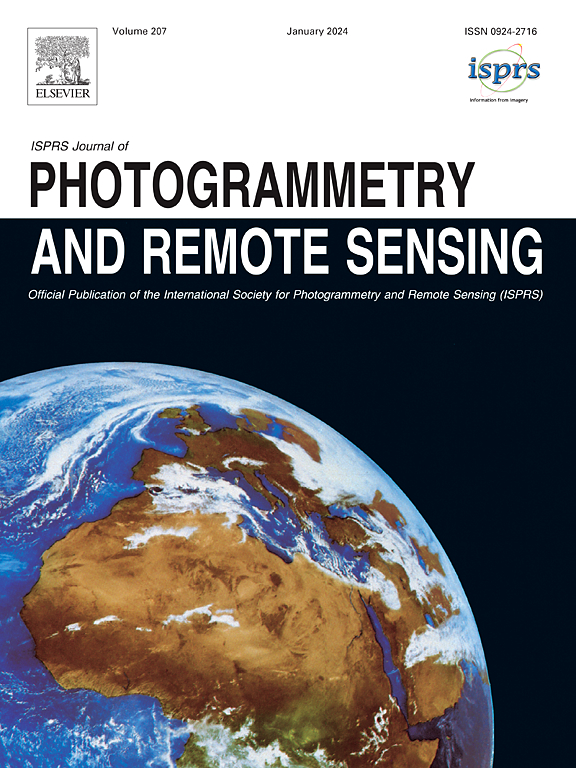Optimizing hybrid models for canopy nitrogen mapping from Sentinel-2 in Google Earth Engine
IF 10.6
1区 地球科学
Q1 GEOGRAPHY, PHYSICAL
ISPRS Journal of Photogrammetry and Remote Sensing
Pub Date : 2024-11-22
DOI:10.1016/j.isprsjprs.2024.11.005
引用次数: 0
Abstract
Canopy nitrogen content (CNC) is a crucial variable for plant health, influencing photosynthesis and growth. An optimized, scalable approach for spatially explicit CNC quantification using Sentinel-2 (S2) data is presented, integrating PROSAIL-PRO simulations with Gaussian Process Regression (GPR) and an Active Learning technique, specifically the Euclidean distance-based diversity (EBD) approach for selective sampling. This hybrid method enhances training dataset efficiency and optimizes CNC models for practical applications. Two GPR models based on PROSAIL-PRO variables were evaluated: a protein-based model (C-LAI) and a chlorophyll-based model (C-LAI). Both models, implemented in Google Earth Engine (GEE), demonstrated strong performance and outperformed other machine learning methods, including kernel ridge regression, principal component regression, neural network, weighted k-nearest neighbors regression, partial least squares regression and least squares linear regression. Validation results showed moderate to good accuracies: NRMSE = 16.76%, R = 0.47; NRMSE = 18.74%, R = 0.51. The models revealed high consistency for an independent validation dataset of the Munich-North-Isar (Germany) test site, with R values of 0.58 and 0.71 and NRMSEs of 21.47% and 20.17% for the C-LAI model and C-LAI model, respectively. The models also demonstrated high consistency across growing seasons, indicating their potential for time series analysis of CNC dynamics. Application of the S2-based mapping workflow across the Iberian Peninsula, with estimates showing relative uncertainty below 30%, highlights the model’s broad applicability and portability. The optimized EBD-GPR-CNC approach within GEE supports scalable CNC estimation and offers a robust tool for monitoring nitrogen dynamics.
在谷歌地球引擎中优化利用哨兵 2 号卫星绘制冠层氮含量图的混合模型
冠层氮含量(CNC)是植物健康的关键变量,影响着光合作用和生长。本文介绍了一种利用哨兵-2(Sentinel-2,S2)数据进行空间显式氮含量量化的优化、可扩展方法,该方法将 PROSAIL-PRO 模拟与高斯过程回归(GPR)和主动学习技术(特别是用于选择性采样的基于欧氏距离的多样性(EBD)方法)相结合。这种混合方法提高了训练数据集的效率,优化了 CNC 模型的实际应用。评估了两个基于 PROSAIL-PRO 变量的 GPR 模型:一个基于蛋白质的模型(Cprot-LAI)和一个基于叶绿素的模型(Cab-LAI)。这两个模型都是在谷歌地球引擎(GEE)中实现的,表现出色,优于其他机器学习方法,包括核岭回归、主成分回归、神经网络、加权 k 近邻回归、偏最小二乘回归和最小二乘线性回归。验证结果显示了中等到良好的精确度:NRMSECprot-LAI = 16.76%,RCprot-LAI2 = 0.47;NRMSECab-LAI = 18.74%,RCab-LAI2 = 0.51。这些模型在慕尼黑-北伊萨尔(德国)试验场的独立验证数据集上显示出高度一致性,Cprot-LAI 模型和 Cab-LAI 模型的 R2 值分别为 0.58 和 0.71,NRMSE 分别为 21.47% 和 20.17%。这些模型在不同的生长季节也表现出高度的一致性,表明它们具有对 CNC 动态进行时间序列分析的潜力。基于 S2 的绘图工作流程在伊比利亚半岛的应用,估算结果显示相对不确定性低于 30%,这突出表明了该模型的广泛适用性和可移植性。在 GEE 中优化的 EBD-GPR-CNC 方法支持可扩展的 CNC 估算,为监测氮动态提供了一个强大的工具。
本文章由计算机程序翻译,如有差异,请以英文原文为准。
求助全文
约1分钟内获得全文
求助全文
来源期刊

ISPRS Journal of Photogrammetry and Remote Sensing
工程技术-成像科学与照相技术
CiteScore
21.00
自引率
6.30%
发文量
273
审稿时长
40 days
期刊介绍:
The ISPRS Journal of Photogrammetry and Remote Sensing (P&RS) serves as the official journal of the International Society for Photogrammetry and Remote Sensing (ISPRS). It acts as a platform for scientists and professionals worldwide who are involved in various disciplines that utilize photogrammetry, remote sensing, spatial information systems, computer vision, and related fields. The journal aims to facilitate communication and dissemination of advancements in these disciplines, while also acting as a comprehensive source of reference and archive.
P&RS endeavors to publish high-quality, peer-reviewed research papers that are preferably original and have not been published before. These papers can cover scientific/research, technological development, or application/practical aspects. Additionally, the journal welcomes papers that are based on presentations from ISPRS meetings, as long as they are considered significant contributions to the aforementioned fields.
In particular, P&RS encourages the submission of papers that are of broad scientific interest, showcase innovative applications (especially in emerging fields), have an interdisciplinary focus, discuss topics that have received limited attention in P&RS or related journals, or explore new directions in scientific or professional realms. It is preferred that theoretical papers include practical applications, while papers focusing on systems and applications should include a theoretical background.
 求助内容:
求助内容: 应助结果提醒方式:
应助结果提醒方式:


